- 1School of Electronic and Information Engineering, Zhongshan Institute, University of Electronic Science and Technology of China, Zhongshan, China
- 2Institute of Applied Physics and Computational Mathematics, Beijing, China
- 3School of Materials Science and Engineering and Guangxi Key Laboratory of Information Materials, Guilin University of Electronic Technology, Guilin, China
- 4Guilin Key Laboratory of Microelectronic Electrode Materials and Biological Nanomaterials and National Special Mineral Materials Engineering Technology Research Center and Guangxi Key Laboratory of Superhard Materials, China Monferrous Metal (Guilin) Geology and Mining Co., Ltd, Guilin, China
Non-invasive detection of the Majorana bound state (MBSs), a kind of quasiparticle without charge and mass, is one of the core issues in current condensed matter physics. Here we study in theory the quantum interference effect in parallel-coupled double quantum dots which are connected either by Majorana bound states (MBSs) or regular fermions. We find that the zero-energy conductance develops a sharp peak when the dots are connected by the MBSs, whereas that in the case of the dots are coupled via regular fermions shows a valley. By varying the coupling strength between the dots and the electron reservoirs, the conductance in the two structures changes in different ways. By comparing the properties of the linear conductance in the two systems, the information of the MBSs formed at the two ends of a topological superconductor nanowire then can be inferred. We also find that the MBSs in the present structure also induces the Fano effect, and is favorable in quantum information processing.
Introduction
In recent years, the preparation and detection of the exotic self-conjugate Majorana fermions have been extensively studied both experimentally and theoretically [1–3]. In solid platforms, they are realized in the form of zero-energy Majorana bound states (MBSs), and are promising in fault-tolerant quantum computing over the last two decades because of their non-Abelian statistics and robustness against decoherence [4, 5]. Up to now, MBSs have been prepared in various setups, in which the simplest and the most frequently studied one is perhaps the topological superconducting nanowires (TSNW). It involves the use of a nanowire having strong spin-orbit interactions under a uniform magnetic field in the proximity of an s-wave superconductor [5–7]. The magnetic field breaks the time-reversal symmetry in the TSNW and produces spinless electrons with p-wave superconducting pairing [5–7]. With the rapid developments of the nano-fabrications, the MBSs have also be successfully prepared in semiconducting nanowires [8, 9], magnetic atom chains [10], and planar Josephson junctions [11, 12].
The detection of the MBSs is quite challenging due to its charge neutrality and massless nature. One of the current strong evidence of the existence of MBSs is the zero-bias anomaly of the conductance peak in tunnel-spectroscopy experiments [7, 11], which means that under the condition zero bias, the conductance develops a peak other than the usual zero value. The zero-bias anomaly of the conductance arises from the hybridization between the quantum dot and the Majorana bound state, and then can be used for deducing the existence of the latter. However, such a phenomenon can also arise from some other mechanisms, such as the Kondo effect [13–15]. The Josephson effect has also been extensively investigated due to its phase-sensitive nature as the MBSs in a Josephson junction enable a nontrivial Josephson current having 4π periodicity in the Josephson phase [1, 11, 12]. This is quite different from the Josephson current with 2π periodicity in the usual junctions. Meanwhile, there were also some proposes of hybridizing a quantum dot (QD) to one end of a TSNW [16–20] in that the information of the MBSs will “leak” into the QD and then can be detected by spectroscopy transport measurements in a non-invasive way [21, 22]. Some other proposals such as the thermoelectric effect [23] and optical schemes [24, 25] based on QDs were also put forward. For example in Ref. 24, they argued that the MBSs will absorb and emit photons leading photon-assisted side band peaks. Such processes result in non-zero MBSs mode and then indicate a novel detection scheme for MBSs. The height of the photon-induced side band peaks is proportional to the magnitude of the photon field, and the time-dependent conductance is negative for a certain period of time in the presence of the MBSs [24].
Electronic transport through QD structures has been an active research subject during the past several decades [26, 27]. Due to the confinement of electrons in both the three directions, QD is characterized by the quantized energy levels, and is usually called ‘‘artificial atoms’’ [26]. Coherence of electrons tunneling through QD is greatly preserved, which has been demonstrated in phenomena such as the Aharonov-Bohm oscillations in closed ring-shape geometries [28], the subtle Kondo effect in QD connected to leads [13, 14, 29], and Fano resonances in systems with multiple channels [26–29]. In fact, two or more QDs coupled to each other will form an ‘‘artificial molecule’’ and result in the formation of bonding and antibonding states that are interesting in potential applications in quantum computing devices [26–29]. A lot of research works then have been carried out on the quantum interference effects in diverse parallel and T-shaped setups. In the systems of hybridized QD-TSNW, there is usually more than one electron transport channels and the quantum interference effect is an efficient mean to detect the existence of the MBSs formed at the ends of the TSNW [30–35]. For example, it was shown that when the MBSs is coupled to the QD in multiple channel systems, antiresonance in the conductance emerges and its location depends on the direct hybridization between the MBSs [32, 33]. If the coupling strengths between the QD and the two modes of the MBSs are the same, the Fano effect is induced as the Fano lineshape in the conductance or spectrum function [35]. Such interesting results may provide new information for the detection of the MBSs or find practical applications in design of high-efficiency quantum devices.
In the present paper, we study Fano effect in parallel double QDs in the presence of MBSs. We consider the cases of the two dots are simultaneously coupled to the left and right leads with different strengths, and to each other by the TNSW hosting MBSs (QD-MBSs). Our numerical results show that the zero-energy conductance is sensitive to the dot-lead coupling. We also compare the results in our QD-MBSs structure with those in the QDs connected to each other by the usual tunnel junction or regular fermions (another QD), and show that the central (zero-energy) peak in the two cases undergoes a peak to valley evolution, which can be used for detecting the MBSs.
Model and Methods
The schematic plot of the present structure is shown in Figure 1, in which two QDs are simultaneously coupled to the left and right leads with different coupling strengths, and connected to each other by a TNSW with MBSs. The Hamiltonian can be written as the following form Refs. 36–40,
where the creation (annihilation) operator
in which λi is the hybridization amplitude between the QD-i and the mode-i of the MBSs, and the self-conjugate nature of the MBSs requires
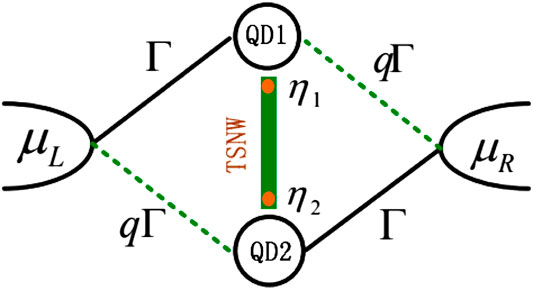
FIGURE 1. Schematic plot of the parallel double QDs coupled to the left and right leads with coupling strength
At ultra-low temperature favorable for the preparation of the MBSs, the linear conductance G is obtained with the help of the transmission T(ε) of an electron by the Landauer formula G = (2e2/h)T(ε). The transmission coefficient is calculated in terms of the Green’s functions as
in which the
Results and Discussion
In the following numerical calculations, we fix the line-width function
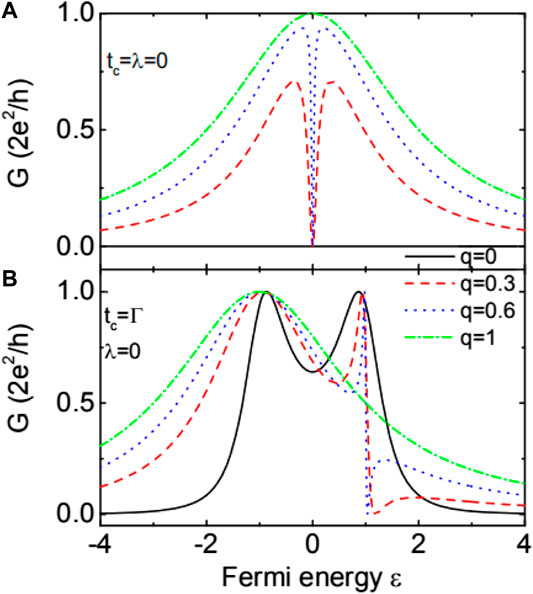
FIGURE 2. Linear conductance varying as a function of the Fermi energy in the absence of QD-MBSs coupling
From above equation, one can see that G develops a dip at ε = 0, and has two resonances located at
For q = 0 (serially connected double QDs), the conductance shows two Lorentz peaks at the bonding and antibonding states, respectively. Whereas for 0 < q < 1, the resonance at the antibonding state ε = tc shows the typical asymmetrical Fano line-shape, which has been systematically investigated in Refs. 28 and 31 and we do not discuss them in more detail.
We now study the case of the two QDs are connected by the MBSs (DQD-MBSs configuration) in Figure 3A, and also shows the results when the two dots are connected by regular fermions (TQD configuration). For q = 0, the conductance remains at zero in that the electrons can not transport through the TSNW for
from which the retarded Green’s function and the conductance can be easily obtained by the equation of motion method in the absence of Coulomb interaction between the electrons [41].
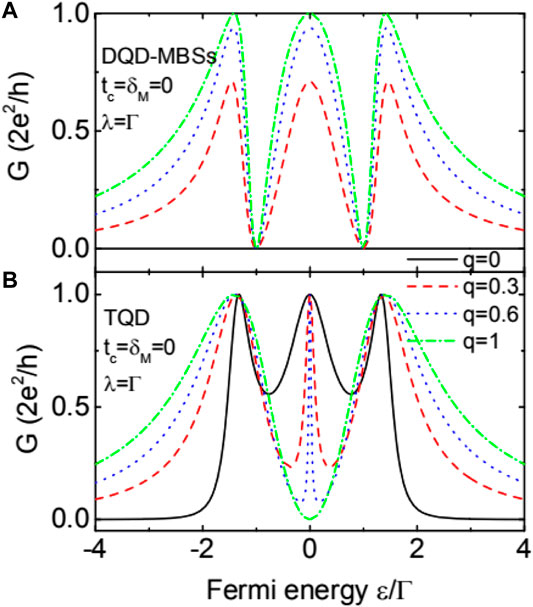
FIGURE 3. Dependence of the linear conductance on the Fermi energy for the case of the double QDs are coupled to each other by the MBSs (DQD-MBSs) in (A) and the case of the two QDs connected by regular fermions, i.e., another QD in (B). The latter corresponds to the triple-QD (TQD) configuration.
As shown in Figure 3B, the conductance develops triple peaks for 0 ≤ q < 1 with unchanged peaks’ value
Figure 4 presents the calculation results in structures of DQD-MBSs (black solid line) and TQD (red dashed line) with varied inter-MBSs coupling strength δM (or energy level of dot-3). For small value
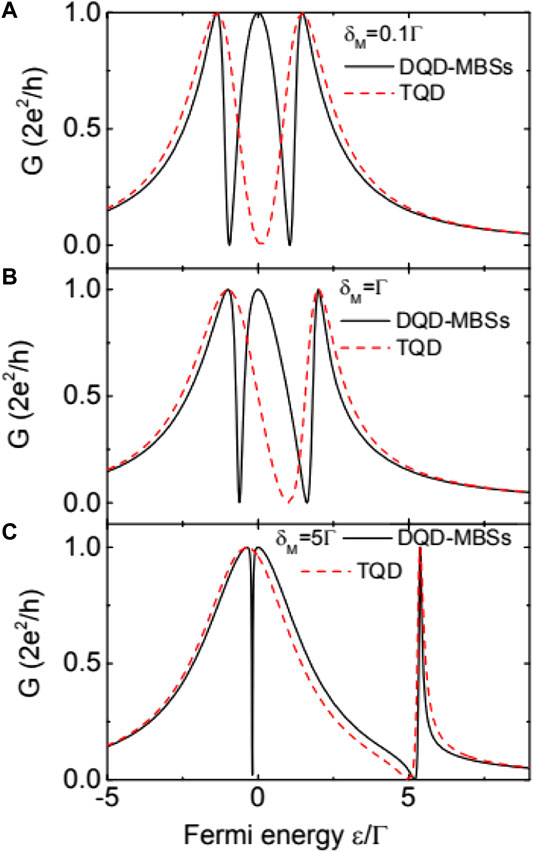
FIGURE 4. Linear conductance as a function of the Fermi energy for DQD-MBSs and TQD configurations and different values of direct overlap amplitude δM and fixed λ = 1 and q = 1. In (A) we set
Finally, we study the conductance in Figure 5 for different values of q and fixed
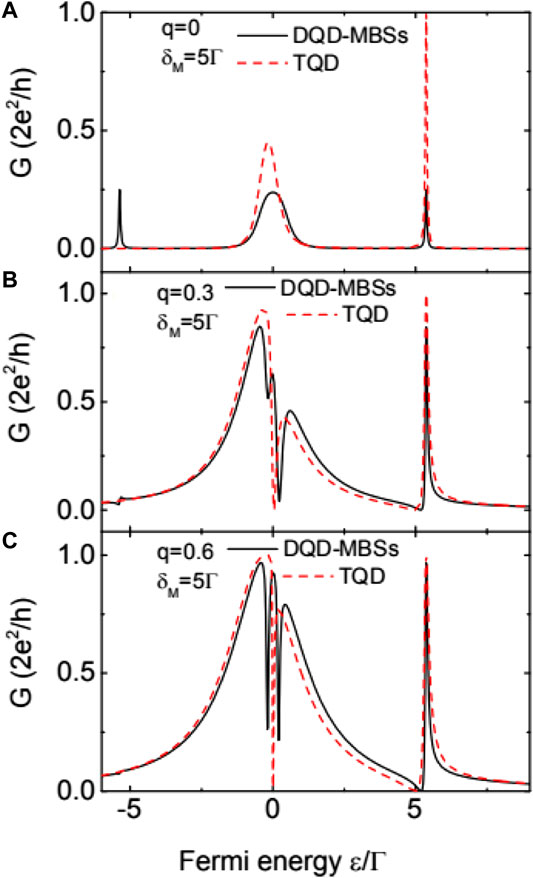
FIGURE 5. Linear conductance as a function of the Fermi energy for DQD-MBSs and TQD configurations for q = 0 in (A), q = 0.3 in (B), q = 0.6 in (C). Except the parameters given in the figure, others are as in Figure 4.
Summary
In summary, we have studied the properties of the conductance in double QDs coupled to the left and right leads in parallel configuration within the framework of the Green’s function method. We find that when the two dots are connected by a TSNW with MBSs at its two ends, the conductance develops three peaks, whose height is enhanced with increasing left-right symmetry. Between the peaks, there are two dips with zero conductance. If the dots are connected by regular fermions, however, the dips is nonzero, and the central peaks will evolve into a dip if the system is totally symmetric in left-right coupling strength. Such a peak to valley change of the conductance provides a non-invasive detection of the MBSs. When the MBSs formed at the ends of the TSNW is overlapped, the resonances at zero and positive energy regimes will display the typical Fano line-shape, which is useful in quantum information processing or design of novel quantum devices.
Data Availability Statement
The original contributions presented in the study are included in the article/Supplementary Material, further inquiries can be directed to the corresponding authors.
Author Contributions
FC and Z-GF contributed the ideas equally and derived the formulae. JW and T-YH performed the numerical calculations. FC, Z-GF, and PZ wrote the original manuscript. X-WZ, LW, and ZL helped to discussed the results and polished the manuscript.
Funding
This research was supported by the NSFC (Grant No. 62075035), the Initial Project of UEST of China, Zhongshan Institute (415YKQ02), Project for Innovation Team of Guangdong University (No. 2018KCXTD033), Science and Technology Bureau of Zhongshan (Grant No. 2017B1116, 180809162197886), and the Research Funds for Beijing Universities (NO.KM201910009002). X-W Zhang acknowledges support from Key Research and Development Program of Guangxi (GuiKeAB19110032).
Conflict of Interest
Authors LW and ZL are employed by China Monferrous Metal (Guilin) Geology and Mining Co., Ltd.
The remaining authors declare that the research was conducted in the absence of any commercial or financial relationships that could be construed as a potential conflict of interest.
References
1. Kitaev AY Unpaired majorana fermions in quantum wires. Phys Usp (2001) 44(10):131–6. doi:10.1070/1063-7869/44/10S/S29
2. Nayak C, Simon SH, Stern A, Freedman M, Das Sarma S Non-Abelian anyons and topological quantum computation. Rev Mod Phys (2008) 80(3):1083–1159. doi:10.1103/revmodphys.80.1083
3. Alicea J New directions in the pursuit of Majorana fermions in solid state systems. Rep Prog Phys (2012) 75(7):076501. doi:10.1088/0034-4885/75/7/076501
4. Sau JD, Lutchyn RM, Tewari S, Das Sarma S Generic new platform for topological quantum computation using semiconductor heterostructures. Phys Rev Lett (2010) 104(4):040502. doi:10.1103/PhysRevLett.104.040502
5. Karzig T, Knapp C, Lutchyn RM, Bonderson P, Hastings MB, Nayak C, et al. Scalable designs for quasiparticle-poisoning-protected topological quantum computation with Majorana zero modes. Phys Rev B (2017) 95(23):235305. doi:10.1103/physrevb.95.235305
6. Oreg Y, Refael G, von Oppen F Helical liquids and Majorana bound states in quantum wires. Phys Rev Lett (2010) 105(17):177002. doi:10.1103/PhysRevLett.105.177002
7. Mourik V, Zuo K, Frolov SM, Plissard SR, Bakkers EP, Kouwenhoven LP Signatures of Majorana fermions in hybrid superconductor-semiconductor nanowire devices. Science (2012) 336(6084):1003–7. doi:10.1126/science.1222360
8. Deng MT, Vaitiekėnas S, Hansen EB, Danon J, Leijnse M, Flensberg K, et al. Majorana bound state in a coupled quantum-dot hybrid-nanowire system. Science (2016) 354(6319):1557–62. doi:10.1126/science.aaf3961
9. Zhang H, Liu CX, Gazibegovic S, Xu D, Logan JA, Wang G, et al. Quantized Majorana conductance. Nature (2018) 556(7699):74–9. doi:10.1038/nature26142
10. KouwenhovenXu S, Xie Y, Li J, Wang Z, Bernevig BA, Yazdani A Distinguishing a Majorana zero mode using spin-resolved measurements. Science (2017) 358(6364):772–6. doi:10.1126/science.aan3670
11. Fornieri A, Whiticar AM, Setiawan F, Portolés E, Drachmann ACC, Keselman A, et al. Evidence of topological superconductivity in planar Josephson junctions. Nature (2019) 569(7754):89–92. doi:10.1038/s41586-019-1068-8
12. NichelePortolés H, Pientka F, Hart S, Pierce A, Kosowsky M, Lunczerau L, et al. Topological superconductivity in a phase-controlled Josephson junction. Nature (2019) 569(7754):93–8. doi:10.1038/s41586-019-1148-9
13. YacobyPierce A, Das A, Ronen Y, Most Y, Oreg Y, Heiblum M, et al. Zero-bias peaks and splitting in an Al-InAs nanowire topological superconductor as a signature of Majorana fermions. Nat Phys (2012) 8(12):887–95. doi:10.1038/NPHYS2479
14. Górski G, Kucab K The spin-dependent coupling in the hybrid quantum dot–Majorana wire system. Phys Status Solidi B-Basic Solid State Phys (2019) 256(3):1800492. doi:10.1002/pssb.201800492
15. Weymann I, Wojcik KP, Majek P Majorana-Kondo interplay in T-shaped double quantum dots. Phys Rev B (2020) 101(23):235404. doi:10.1103/PhysRevB.101.235404
16. Yi GY, Jiang C, Zhang LL, Zhong SR, Chu H, Gong WJ, et al. Manipulability of the Kondo effect in a T-shaped triple-quantum-dot structure. Phys Rev B (2020) 102(8):085418. doi:10.1103/PhysRevB.102.085418
17. Feng JJ, Huang Z, Wang Z, Niu Q Josephson radiation from nonlinear dynamics of Majorana zero modes. Phys Rev B (2020) 101(18):180504. doi:10.1103/PhysRevB.101.180504
18. Liu DE, Cheng M, Lutchyn RM Probing Majorana physics in quantum-dot shot-noise experiments. Phys Rev B (2015) 91(8):081405. doi:10.1103/PhysRevB.91.081405
19. Liu DE, Baranger HU Detecting a Majorana-fermion zero mode using a quantum dot. Phys Rev B (2011) 84(20):201308. doi:10.1103/PhysRevB.84.201308
20. Sherman D, Yodh JS, Albrecht SM, Nygård J, Krogstrup P, Marcus CM Normal, superconducting and topological regimes of hybrid double quantum dots. Nat Nanotechnol (2016) 12(3):212–7. doi:10.1038/nnano.2016.227
21. Ricco LS, Campo VL, Shelykh IA, Seridonio AC Majorana oscillations modulated by Fano interference and degree of nonlocality in a topological superconducting-nanowire–quantum-dot system. Phys Rev B (2018) 98(7):075142. doi:10.1103/PhysRevB.98.075142
22. Ricco LS, de Souza M, Figueira MS, Shelykh IA, Seridonio AC Spin-dependent zero-bias peak in a hybrid nanowire-quantum dot system: distinguishing isolated Majorana fermions from Andreev bound states. Phys Rev B (2019) 99(15):155159. doi:10.1103/PhysRevB.99.155159
23. López R, Lee M, Serra L, Lim JS Thermoelectrical detection of Majorana states. Phys Rev B (2014) 89(20):205418. doi:10.1103/PhysRevB.89.205418
24. Tang HZ, Zhang YT, Liu JJ Photon-assisted tunneling through a topological superconductor with Majorana bound states. AIP Adv (2015) 5(12):127129. doi:10.1063/1.4939096
25. Chi F, He TY, Wang J, Fu ZG, Liu LM, Liu P, et al. Photon-assisted transport through a quantum dot side-coupled to Majorana bound states. Front Phys (2020) 8:254. doi:10.3389/fphy.2020.00254
26. Van der Wiel WG, De Franceschi S, Elzerman JM, Fujisawa T, Tarucha S, Kouwenhoven LP Electron transport through double quantum dots. Rev Mod Phys (2002) 75(1):1–22. doi:10.1103/RevModPhys.75.1
27. Hanson R, Kouwenhoven LP, Petta JR, Tarucha S, Vandersypen LMK Spins in few-electron quantum dots. Rev Mod Phys (2007) 79(4):1217–65. doi:10.1103/RevModPhys.79.1217
28. Chi F, Liu JL, Sun LL Fano-Rashba effect in a double quantum dot Aharonov-Bohm interferometer. J Appl Phys (2007) 101(9):093704. doi:10.1063/1.2720097
29. Hofstetter W, König J, Schoeller H Kondo correlations and the Fano effect in closed Aharonov-Bohm interferometers. Phys Rev Lett (2001) 87(15):156803. doi:10.1103/PhysRevLett.87.156803
30. Miroshnichenko AE, Flach S, Kivshar YS Fano resonances in nanoscale structures. Rev Mod Phys (2010) 82(3):2257–98. doi:10.1103/RevModPhys.82.2257
31. de Guevara MLL, Claro F, Orellana PA Ghost Fano resonance in a double quantum dot molecule attached to leads. Phys Rev B (2003) 67(19):195335. doi:10.1103/PhysRevB.67.195335
32. Li YX, Bai ZM Tunneling transport through multi-quantum-dot with Majorana bound states. J Appl Phys (2013) 114(3):033703. doi:10.1063/1.4813229
33. Wang N, Lv SH, Li YX Quantum transport through the system of parallel quantum dots with Majorana bound states. J Appl Phys (2014) 115(8):083706. doi:10.1063/1.4867040
34. Xia JJ, Duan SQ, Zhang W Detection of Majorana fermions by Fano resonance in hybrid nanostructures. Nanoscale Res Lett (2015) 10:223. doi:10.1186/s11671-015-0914-3
35. Jiang C, Zheng YS Fano effect in the Andreev reflection of the Aharonov-Bohm-Fano ring with Majorana bound states. Solid State Commun (2015) 212:14–18. doi:10.1016/j.ssc.2015.04.001
36. Ueda A, Yokoyama T Anomalous interference in Aharonov-Bohm rings with two Majorana bound states. Phys Rev B (2014) 90(8):081405. doi:10.1103/PhysRevB.90.081405
37. Zeng QB, Chen S, Rong L Fano effect in an AB interferometer with a quantum dot side-coupled to a single Majorana bound state. Phys Lett (2016) 380:951–7. doi:10.1016/j.physleta.2015.12.026
38. Ivanov TI Coherent tunneling through a double quantum dot coupled to Majorana bound states. Phys Rev B (2017) 96(3):035417. doi:10.1103/PhysRevB.96.035417
39. Cifuentes JD, Dias da Silva LGGV Manipulating Majorana zero modes in double quantum dots. Phys Rev B (2019) 100(8):085429. doi:10.1103/PhysRevB.100.085429
40. Tang LW, Mao WG Detection of Majorana bound states by sign change of the tunnel magnetoresistance in a quantum dot coupled to ferromagnetic electrodes. Front Phys (2020) 8(5):147. doi:10.3389/fphy.2020.00147
Keywords: quantum dots, Majorana bound states, quantum interference, Fano effect, antiresonance
Citation: Chi F, Wang J, He T-Y, Fu Z-G, Zhang P, Zhang X-W, Wang L and Lu Z (2021) Quantum Interference Effects in Quantum Dot Molecular With Majorana Bound States. Front. Phys. 8:631031. doi: 10.3389/fphy.2020.631031
Received: 19 November 2020; Accepted: 09 December 2020;
Published: 18 January 2021.
Edited by:
Guofu Zhou, South China Normal University, ChinaReviewed by:
Yingjie Chen, Qufu Normal University, ChinaXiu Qing Wang, Inner Mongolia University for Nationalities, China
Copyright © 2021 Chi, Wang, He, Fu, Zhang, Zhang, Wang and Lu. This is an open-access article distributed under the terms of the Creative Commons Attribution License (CC BY). The use, distribution or reproduction in other forums is permitted, provided the original author(s) and the copyright owner(s) are credited and that the original publication in this journal is cited, in accordance with accepted academic practice. No use, distribution or reproduction is permitted which does not comply with these terms.
*Correspondence: Feng Chi, Y2hpZmVuZ0BzZW1pLmFjLmNu; Zhen-Guo Fu, ZnVfemhlbmd1b0BpYXBjbS5hYy5jbg==
 Feng Chi
Feng Chi Jing Wang1
Jing Wang1 Zhen-Guo Fu
Zhen-Guo Fu Ping Zhang
Ping Zhang